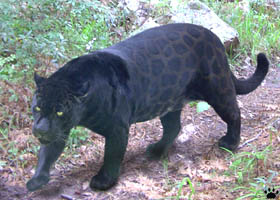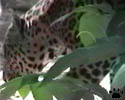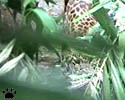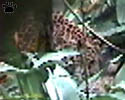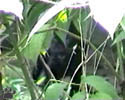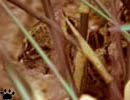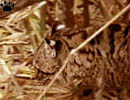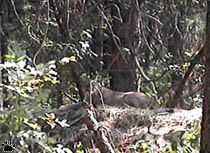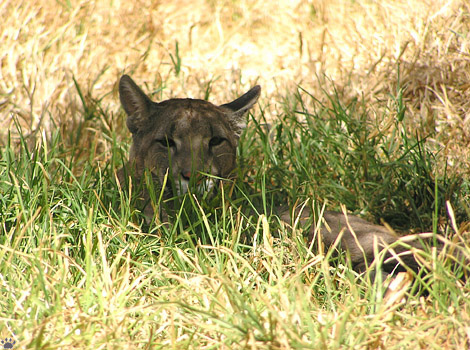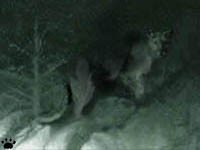Wild Cats Except for lions, tigers and cheetahs in some African and Indian parks, wild cats
are among the most difficult animals to see; and to get their pictures in the
wild is sometimes almost impossible. For me it's always been a challenge, and
I've spent hundreds of hours walking through moonlit forests, swimming in tropical
rivers, or slowly freezing in treetop ambushes in search of them. Although I've
already seen all but 2 of 35-40 existing species (some forms can be counted as either
full species or races), I have very few pictures, and most of them
are of poor quality. Still, the animals themselves are so beautiful, that even
bad photos are sometimes nice to look at. Note: I do not accept the recent attempts to divide small cats (Felis) into many small genera. I don't see any way to do it that would result in creating natural groups: some species are intermediate and won't fit into any such system. Besides, there are too many known cases of "intergeneric" hybridization in captivity (F. catus X F. bengalensis and F. concolor X Panthera pardus, for example), or even in the wild (F. rufus X F. pardalis), sometimes producing fertile offspring. I believe that cats are a very homogenous group if compared to other carnivores, so having 2-3 genera in the family better reflects its natural status. |
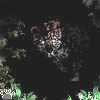 Siberian leopard, Kedrovaya Pad', Russia. |
The easiest way to see forest cats is to hike along forest trails at night. Cats have soft paws and always enjoy using good paths. I recommend using two sources of light: small headlamp to locate cats by their eyeshine, and large flashlight to turn on if you need a better view. Soft shoes are essential. In warm weather, try to avoid using any clothes (they make subtle noises when you walk). Unlike many other mammals, cats are not usually scared away by the smell of a mosquito repellent. Always listen for alarm calls of forest birds and mammals - they can lead you to a wild cat or other predator. | |
| Another way of observing cats on forest trails is to find a good observation point close to the trail, and spend a few nights watching for passing animals. Small cats usually visit every part of their individual territory more or less often, but large ones can use the same trail only once or twice a month. Be patient: even if you don't see a cat, there will be some other animals to watch. The nights I spent on roadside trees in Chitwan Nat'l Park, Nepal, were among the best in my life: I didn't see a tiger, but there were deer, sloth bears, ghaurs, porcupines, and rhinos passing by. A large branch above the trail is often a good choice, as long as you are sure you'll not fall down. For some reason, most animals don't pay attention even if they see you above the trail, like this leopard in Ussuriland (right). | 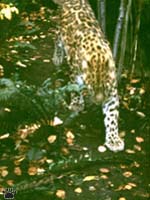 Siberian leopard, Kedrovaya Pad', Russia. |
  Leopard stalking prey, Vadi Abdullah, Israel. |
Arabian leopard (Panthera
pardus nimr) is the smallest race of leopard, and one of the most beautiful:
dark spots are scattered on almost white fur. You'll have a good chance to see
it if you'll arrange visiting Ein Gedi Nature Reserve (Israeli side of the Dead
Sea) after regular tourist hours, or hike down some of the canyons
from Judean Desert near Hebron to the Dead Sea coast. Better do it at night: leopards
are nocturnal, and resident people mostly diurnal. For other subspecies of leopards, good places are Kedrovaya Pad' Reserve (Russia) for Siberian leopard (P. p. orientalis), Kyzyljar Canyon in Badkhyz Reserve (Turmenistan) for Persian leopard (P. p. saxicolor), and, reportedly, Wilpattu Nat'l Park for Sri Lankan leopard (P .p. kotya). |
|
| Here are snapshots from a video I filmed in Panti Forest Reserve, Malaysia, using a roadkill goat as bait. As soon as these two leopards arrived, they dragged the goat into dense bushes, so in six hours of watching them I never got a good view. (Systematics of leopards are now changing, with number of recognized subspecies being reduced, so animals of Yunnan, Indochina, Malay Peninsula, and Java should probably be called Malay leopards (P. p. melas). China/Laos border in Xishuanbana region is another good place to see them.) |
|
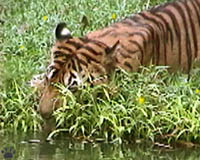 Tiger drinking from roadside ditch, Panti F. R. |
Soon after the two leopards had left, I was awarded for my long wait in a road culvert by another visit. This guest didn't pay attention to the goat, of which only a pile of maggots remained. It gave me twenty seconds of great views at a distance of less than ten meters, before the sound of my camera being turned on scared it away. Local tigers are now considered a distinctive subspecies Malayan tiger (P. tigris jacksoni). | |
| Siberian tigers (P. t. altaica) are elusive: some scientists have never seen one in many years of study. There are 500+ tigers in Ussuriland (roughly the size of Florida), and you can find their tracks on dirt roads in taiga. But these giants are so good at avoiding humans that native Ude people used to believe they were partly supernatural creatures. I took this picture (right) in winter near Ussuri Nature Reserve. |  Tiger tracks, Kamenushka,Russia. |
 Tiger in the moonlight, Kamenushka, Russia. |
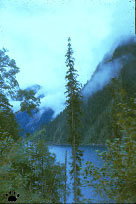 Giant conifers, Jushaigou Nat'l Park, China. |
National Parks of Sichuan, China, are the best place to see some less-known species of cats. Look for beautiful Asian golden cat (Felis temminki) in lower parts of Wolong Panda Reserve, and for small Chinese cat (F. bieti) in northern Sichuan (strangely, I've only seen it in Xilinhot area near Beijing, 200 miles from its known range). Further south, Four Rivers Country and southwestern Yunnan are good for clouded leopard (F. nebulosa). This beautiful cat is now extremely rare throughout its range, and you shouldn't expect to find it within 25 km of any village, road, or large river. It is almost extinct in Nepal, India and most of Indochina. All these species are difficult to see by hiking because of their rarity - consider using meat baits and blinds. | |
| The only relatively reliable place to look for snow leopard (P. uncia) is along timberline in large Nature reserves in Kyrgyzstan and Mongolia. Population density here can be as high as one cat per 400 sq. km. Karakorum and KuenLun mountains above 4000 m are also good, but more remote. Search for snow leopards along rocky ridges above grassy slopes where wild sheep and ibex graze. Each herd of ibex is usually "managed" by one leopard, or by a female with cubs. |  Snow leopard cub, Kiiktash, Kyrgyzstan. |
 Snow leopard in a blizzard, Xingjang/Tibet border near Xahidulla, China |
This picture was taken while hiking along the World's highest auto road during a fierce snowstorm. I had to steal part of the cat's meal (a recently killed blue sheep) for myself. 25 km down the road, I found some coal on a roadside, so I didn't have to eat it raw - lucky day! | |
 Snow leopard, Temirlik River, Kazakhstan. |
These photos belong to Talgat Mergenov, a friend of mine and a long-time game warden. We tracked the animal and photographed it together, so I think it's OK for me to use them on this site. | 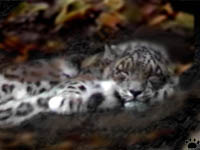 Snow leopard, Temirlik River, Kazakhstan. |
| Cougar, a. k. a. puma or mountain lion (F. concolor puma) can be relatively easy to see in western Patagonia during spring winds. Most animals, including predators, try to hide from the wind in protected ravines. This cat (right) was so busy hunting viscachas (Lagidium wolffsohni), that I took 3 pictures before it noticed me. In tropical America, puma is difficult to see - it is not hunted as often as jaguar, but it doesn't live in riparian forests, so you almost never see it from a river. |  Puma, Torres del Paine, Chile. |
|
(Dusicuon culpaeus), Loma de Fe, Chile. |
Torres del Paine is also good for Geoffroy's cat (F. geoffroyi), pampas cat (F. colocolo pajeros), and southern codcod (F. guigna guigna). The latter is more common in National parks along Carretera Austral further north. |
| Geoffroy's cat is locally common in foothills and river valleys of Argentina, Paraguay and some parts of Chile and Brazil, but it lives in very dense vegetation, and is almost impossible to photograph. This picture (right) took an hour of editing in Photoshop to become viewable. It was taken in the middle of a huge colony of introduced European rabbits (Oryctolagus cuniculus). | 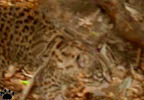 Geoffroy's cat, Torres del Paine. |
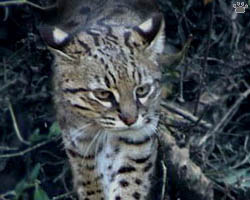 Geoffroy's cat, Calilegua National Park, Argentina. |
I later managed to get two better pictures of Geoffroy's cat in Calilegua National Park, Argentina. | 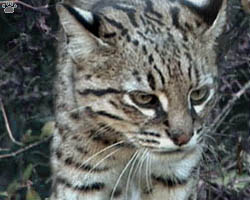 Geoffroy's cat, Calilegua National Park, Argentina. |
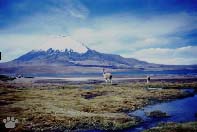 Vicunias (Lama vicunia), Lauca N. Park, Chile. |
Other nice places in Chile are Lauca Nat'l Park for Andean cat (F. jacobita); Fray Jorje Nat'l Park and Las Chinchillas Nat'l Preserve for Chilean pampas cat (F. c. colocolo); Chiloe, Alerce Andino and Conguillo Nat'l Parks for northern codcod (F. g. tigrillo) . Walking around late at night, you can see as many as one cat every 30-50 hours. Codcod is most common in dense forests, pampas cat in open areas, and Andean cat - in puna grasslands.. | |
| Tropical pampas cat (F. c. braccatus) occurs in Northern Argentina and Southern Brazil . But it is much more difficult to see than the other two races, because here it lives in very tall grass, and is better camouflaged. While pampas cats of the Andes and Patagonia are mostly gray, the tropical ones are beautifully spotted. |
|
 |
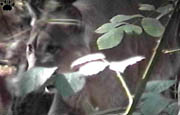 |
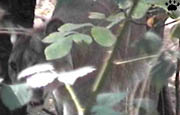 |
| Mountain lion, Los Gatos Mountains, California. | ||
 Tracks of a young mountain lion playing in the snow, Mosquito Ridge, California. |
 Track of a large male mountain lion, Los Gatos, California. |
In North America, the best places to look for mountain lions (F. c. cougar) are Chisos Mountains, Texas, in summer and Santa Lucia Mts., California, in winter. Rocky Mountains, especially in Colorado, Montana and Alberta, also support large populations at lower elevations. Californian animals tend to be less shy, because hunting them is banned here. |
| In fact, mountain lions are common in all coastal mountain ranges of California. They often occur in areas densely populated by people, feeding on black-tailed deer (Odocoileus columbianus), various birds, and occasionally stray dogs or cattle. In California, they also kill people almost yearly. Just as Siberian tigers in Ussuriland, or leopards in India, they have learned to live close to people but remain almost invisible. | 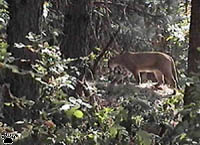 Mountain lion, Los Gatos Mts, California. |
 Mountain lion (F. c. cougar), Mt.Reinier, USA. |
The easiest way to see one is said to be a combination of meat bait and a "fighting mountain lions" tape, commercially available in the US. I didn't use either method much. Cougars are almost never seen while driving at night or hiking, but, like most carnivores, they are very interesting to track, especially if there is snow on the ground. Even if you don't see the animal, following this record of its daily life can be fascinating. | |
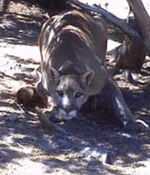 Mountain lion protecting its kill, Wilderness Ridge, New Mexico. I had to throw my coat over his head to stop the attack. Part Two Home |
|||||||||||
